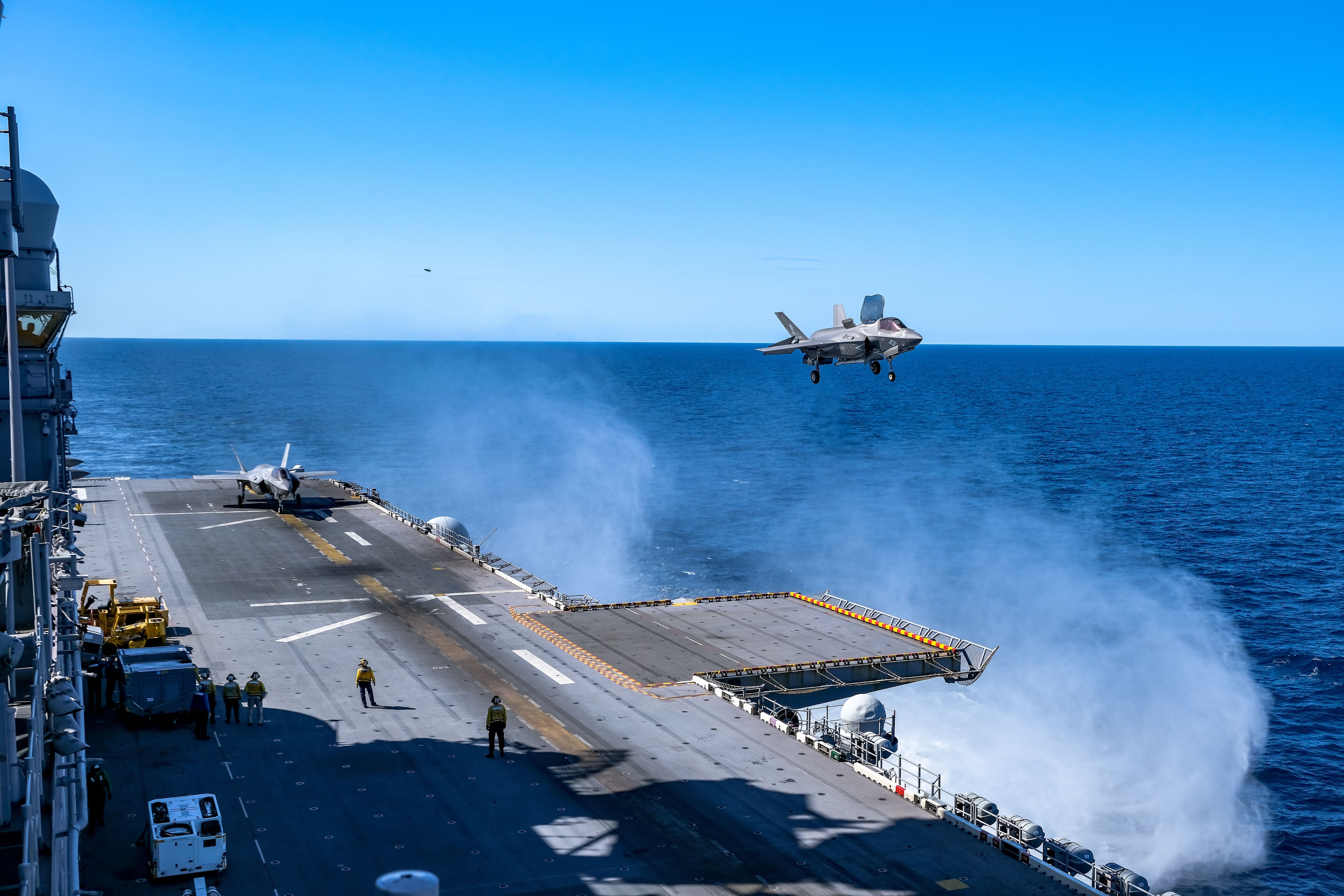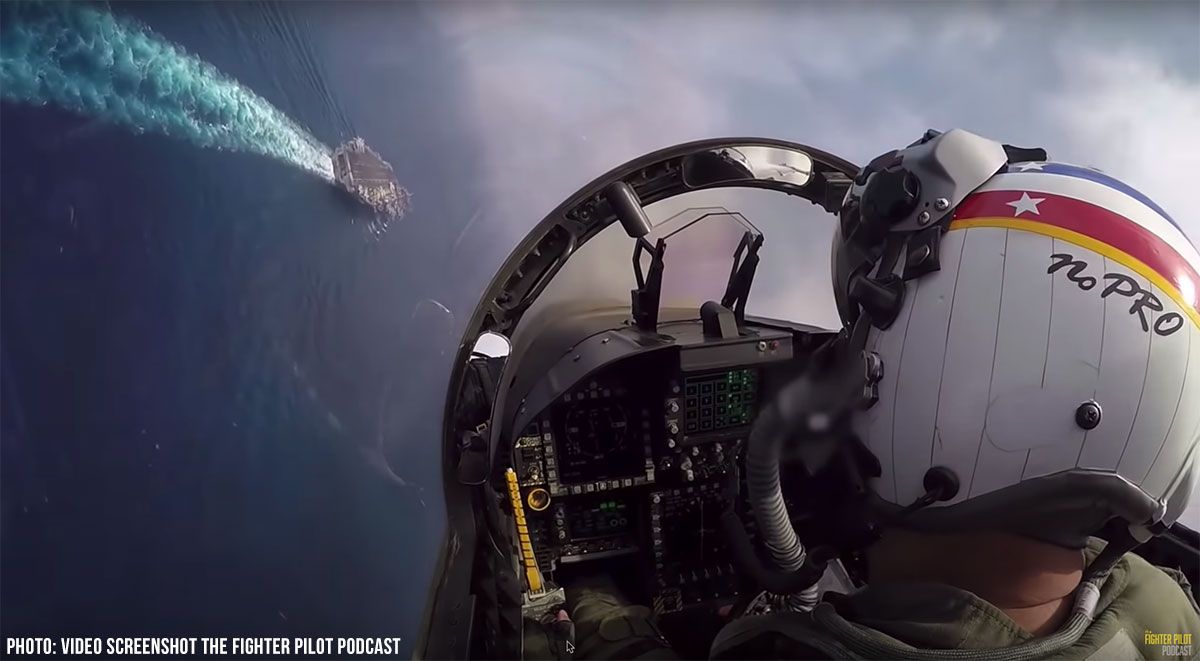Jet Take Off Aircraft Carrier - A Royal Navy source said it was not thought that the F-35 had damaged the ship but said that the carrier would be thoroughly checked - as the vessel would have been anyway - once it returns back to Portsmouth in the coming days at the end of
a seven-month maiden voyage to the Far East and back. What you see here as well as here is the pilot grabbing the handle during takeoff. According to this it is to keep the pilots hands off the controls due to the fact that the natural response to the maneuver would cause the pilot to dive the plane.
Jet Take Off Aircraft Carrier

There is also some discussion on it here which offers a counter point: A carrier aircraft launcher is called a "catapult", for good reason! It's job is to get an aircraft up to flying speed very quickly, which of course results in a very high acceleration for the plane and pilot.
Sometimes as high as 4G. On modern American aircraft carriers, the catapult is about 300 feet (90 meters) long, and can get a large plane up to flying speed, 140 knots, in about 2 seconds. By comparison, taking off on a conventional runway a plane might need 2 kilometers to get up to this speed.
STOL (short takeoff and landing): some airplanes are capable of normal takeoff and landing on the runway lengths provided by an aircraft carrier. This is mostly no longer in use, but it was the way things worked in WW I and WW II.
The world records for STOL airplanes at the moment are about 10 feet for takeoff and under 10 feet for landing. "Given how close the aircraft ditched to the bow, and the speed of the ship on launch, the likelihood of it hitting the bow of the ship (under the waterline) would be quite high," said Commander Tom Sharpe, a former Royal Navy

officer. So some manufacturers added something other than the stick for the pilot to hold during the cat shot. (And the USN procedures have the pilot salute the cat launch controller to show his hand's out of the way.)
No that's not why you hold the towel rack. Yes that inner ear sensation can happen, but that's not why. What about the F-14, or A-7, or literally every other airplane that got shot off the front of an
aircraft carrier that required the pilot's hand to be on the stick to fly it away? Ski Jump: at the end of the deck, the very end of the runway is curved upwards, this gives the airplane additional upward momentum and accelerates it upwards into the air.
Typically used for STOVL airplanes. The most well-known examples are the British aircraft carriers of the last decades. With the 18 you can see that the elevators increase deflection gradually during the shot whereas most other launches have the elevators at full deflection throughout the cat shot.
As the plane leaves the deck the back of the plane is forced down. All pilots salute to signify they are ready for takeoff. They aren't even supposed to put their arms above the canopy rail to avoid accidental shots.

There are hold bars on the throttles of some planes to avoid a situation where the throttles go to idle during the shot. The carrier turns directly into the wind (or in case of an angled flight deck at such an angle that the runway points directly into the wind).
That means, an airplane never has to worry about taking off with a crosswind or tailwind, it will always have a headwind, which increases the airspeed. The video of the incident - which appeared to be authentic - added credibility to a theory that something - like a plastic rain cover - may have been sucked into the aircraft's engine, prompting it to fail.
Watching videos of jets taking off from a carrier, it appears the pilot is holding a hand grip as the jet is catapulted along the deck; then there is a 'jerk' type motion as the jet leaves the deck with the pilot then taking control.
Could you please describe what happens during the take off. It looks like a really rough ride for the pilot. CATOBAR (catapult-assisted takeoff but arrested landing): the airplane spools up its engine(s) to full thrust while being held in place by a restraint system, then gets literally catapulted off the deck with a sled that is attached to the nose wheel
gear and "slings" the airplane forward and accelerates it to takeoff speed. For landing, the airplane extends a tail hook that catches a steel wire on the deck which "pulls" the airplane to a stop. "Warship steel is not that thick so, even despite the weight discrepancy between the two, I would want the compartments near the bow checked immediately... I would then want the hull dived on at the first opportunity, just to be sure."

VTOL (vertical takeoff and landing): some airplanes are able to take off and land vertically. Some examples are the McDonnell Douglas AV-8B Harrier II "Jump Jet" and the F-35B variant of the Lockheed Martin F-35 Lightning II.
The Ministry of Defense will have wanted to be sure no enemy forces are able to access any of the technology on board the top secret aircraft, which is fitted with next generation sensors, radars and other sensitive equipment.
In the early days of catapult launches they discovered that the pilot could not withstand the inertia of his hand slamming backwards at the time of launch. If that hand is holding the stick, then you end up with a large pull back, and thus a large pitch up, which is deemed to be non-optimal at that stage of the flight.
Built by the US firm Lockheed Martin, the UK's F-35s are the B variant of the jet and are flown by pilots from the Royal Air Force and Royal Navy, based at RAF Marham in Norfolk.
The stresses imposed on the airframe by all this violent action are great, requiring very strong construction. The hazards presented by carrier operations are great too; a malfunction of the catapult which causes the plane to not reach flying speed will throw the plane off the bow right into the path of the ship, which then overruns the plane.

And if the tail hook misses all the cables, the plane is at risk of running off the runway and falling into the water. Immediately after the end of the catapult stroke, the aircraft will rotate to capture the
12° reference AOA (hands-off). To avoid PIO with the FCS, do not restrain the stick during catapult launch or make stick inputs immediately after catapult launch. The pilot should attempt to remain out of the loop but should closely monitor the catapult sequence.
Eight - now seven - British F35 jets are on the warship, along with 10 American F35s. They are the B variant of the Lockheed Martin jet, which can take off at a short distance and land on the carrier.
the planes are basically thrown down the runway with a steam-powered catapult that boosts them up to flying speed by the time they reach its end. For landing, they use a tail hook on the plane that catches a cable or series of cables stretched across the runway;
the cable(s) then bring the plane to a quick halt. STOVL (short takeoff / vertical landing): taking off vertically uses a lot of fuel and limits the weight of the airplane (meaning they cannot take as many weapons with them), therefore it is more efficient to have a short takeoff roll and take off

with at least some forward speed. The reason you don't touch the stick in an F-18 is because the F-18 is very sensitive to pitch inputs at slow speed in the takeoff configuration. If you ham-fisted it, you could pull too much angle of
attack too soon and stall. The source noted that - while it is not yet known - even if the aircraft had impacted the carrier it would have had minimal effect on the 65,000-tonne vessel - "like a fly hitting a windscreen".
Each catapult-launched aircraft has different procedures for launch. In the case of the F/A-18, the pilot keeps his hands off the control column during the actual launch, grabbing it as soon as the plane leaves the edge of the deck.
This is not the case for other carrier aircraft, such as the C-2 Greyhound, nor is it the case when taking off the same aircraft from a runway.
planes taking off aircraft carrier, carrier takeoffs, aircraft carrier takeoffs, us aircraft carrier jets, youtube aircraft carrier takeoffs, enterprise aircraft carrier museum, aircraft carrier landings youtube, f18 taking off
0 Comments